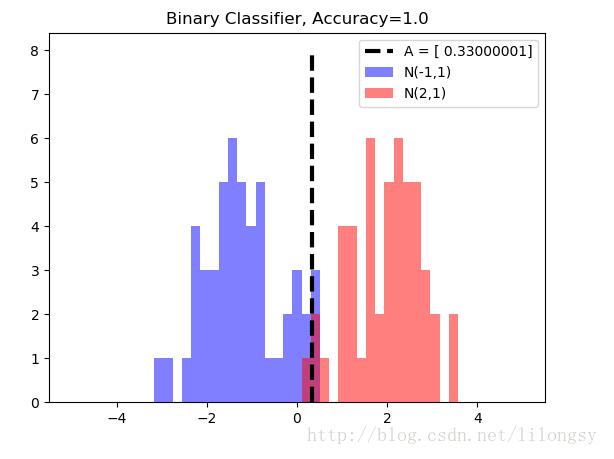在训练模型过程中,模型评估能洞察模型算法,给出提示信息来调试、提高或者改变整个模型。但是在模型训练中并不是总需要模型评估,我们将展示如何在回归算法和分类算法中使用它。
分类算法模型基于数值型输入预测分类值,实际目标是1和0的序列。我们需要度量预测值与真实值之间的距离。分类算法模型的损失函数一般不容易解释模型好坏,所以通常情况是看下准确预测分类的结果的百分比。
# TensorFlowm模型评估## This code will implement two models. The first# is a simple regression model, we will show how to# call the loss function, MSE during training, and# output it after for test and training sets.## The second model will be a simple classification# model. We will also show how to print percent# classified correctly during training and after# for both the test and training sets.import matplotlib.pyplot as pltimport numpy as npimport tensorflow as tffrom tensorflow.python.framework import opsops.reset_default_graph()# 创建计算图sess = tf.Session()# 回归例子:# We will create sample data as follows:# x-data: 100 random samples from a normal ~ N(1, 0.1)# target: 100 values of the value 10.# We will fit the model:# x-data * A = target# 理论上, A = 10.# 声明批量大小batch_size = 25# 创建数据集x_vals = np.random.normal(1, 0.1, 100)y_vals = np.repeat(10., 100)x_data = tf.placeholder(shape=[None, 1], dtype=tf.float32)y_target = tf.placeholder(shape=[None, 1], dtype=tf.float32)# 八二分训练/测试数据 train/test = 80%/20%train_indices = np.random.choice(len(x_vals), round(len(x_vals)*0.8), replace=False)test_indices = np.array(list(set(range(len(x_vals))) - set(train_indices)))x_vals_train = x_vals[train_indices]x_vals_test = x_vals[test_indices]y_vals_train = y_vals[train_indices]y_vals_test = y_vals[test_indices]# 创建变量 (one model parameter = A)A = tf.Variable(tf.random_normal(shape=[1,1]))# 增加操作到计算图my_output = tf.matmul(x_data, A)# 增加L2损失函数到计算图loss = tf.reduce_mean(tf.square(my_output - y_target))# 创建优化器my_opt = tf.train.GradientDescentOptimizer(0.02)train_step = my_opt.minimize(loss)# 初始化变量init = tf.global_variables_initializer()sess.run(init)# 迭代运行# 如果在损失函数中使用的模型输出结果经过转换操作,例如,sigmoid_cross_entropy_with_logits()函数,# 为了精确计算预测结果,别忘了在模型评估中也要进行转换操作。for i in range(100): rand_index = np.random.choice(len(x_vals_train), size=batch_size) rand_x = np.transpose([x_vals_train[rand_index]]) rand_y = np.transpose([y_vals_train[rand_index]]) sess.run(train_step, feed_dict={x_data: rand_x, y_target: rand_y}) if (i+1)%25==0: print('Step #' + str(i+1) + ' A = ' + str(sess.run(A))) print('Loss = ' + str(sess.run(loss, feed_dict={x_data: rand_x, y_target: rand_y})))# 评估准确率(loss)mse_test = sess.run(loss, feed_dict={x_data: np.transpose([x_vals_test]), y_target: np.transpose([y_vals_test])})mse_train = sess.run(loss, feed_dict={x_data: np.transpose([x_vals_train]), y_target: np.transpose([y_vals_train])})print('MSE on test:' + str(np.round(mse_test, 2)))print('MSE on train:' + str(np.round(mse_train, 2)))# 分类算法案例# We will create sample data as follows:# x-data: sample 50 random values from a normal = N(-1, 1)# + sample 50 random values from a normal = N(1, 1)# target: 50 values of 0 + 50 values of 1.# These are essentially 100 values of the corresponding output index# We will fit the binary classification model:# If sigmoid(x+A) < 0.5 -> 0 else 1# Theoretically, A should be -(mean1 + mean2)/2# 重置计算图ops.reset_default_graph()# 加载计算图sess = tf.Session()# 声明批量大小batch_size = 25# 创建数据集x_vals = np.concatenate((np.random.normal(-1, 1, 50), np.random.normal(2, 1, 50)))y_vals = np.concatenate((np.repeat(0., 50), np.repeat(1., 50)))x_data = tf.placeholder(shape=[1, None], dtype=tf.float32)y_target = tf.placeholder(shape=[1, None], dtype=tf.float32)# 分割数据集 train/test = 80%/20%train_indices = np.random.choice(len(x_vals), round(len(x_vals)*0.8), replace=False)test_indices = np.array(list(set(range(len(x_vals))) - set(train_indices)))x_vals_train = x_vals[train_indices]x_vals_test = x_vals[test_indices]y_vals_train = y_vals[train_indices]y_vals_test = y_vals[test_indices]# 创建变量 (one model parameter = A)A = tf.Variable(tf.random_normal(mean=10, shape=[1]))# Add operation to graph# Want to create the operstion sigmoid(x + A)# Note, the sigmoid() part is in the loss functionmy_output = tf.add(x_data, A)# 增加分类损失函数 (cross entropy)xentropy = tf.reduce_mean(tf.nn.sigmoid_cross_entropy_with_logits(logits=my_output, labels=y_target))# Create Optimizermy_opt = tf.train.GradientDescentOptimizer(0.05)train_step = my_opt.minimize(xentropy)# Initialize variablesinit = tf.global_variables_initializer()sess.run(init)# 运行迭代for i in range(1800): rand_index = np.random.choice(len(x_vals_train), size=batch_size) rand_x = [x_vals_train[rand_index]] rand_y = [y_vals_train[rand_index]] sess.run(train_step, feed_dict={x_data: rand_x, y_target: rand_y}) if (i+1)%200==0: print('Step #' + str(i+1) + ' A = ' + str(sess.run(A))) print('Loss = ' + str(sess.run(xentropy, feed_dict={x_data: rand_x, y_target: rand_y})))# 评估预测# 用squeeze()函数封装预测操作,使得预测值和目标值有相同的维度。y_prediction = tf.squeeze(tf.round(tf.nn.sigmoid(tf.add(x_data, A))))# 用equal()函数检测是否相等,# 把得到的true或false的boolean型张量转化成float32型,# 再对其取平均值,得到一个准确度值。correct_prediction = tf.equal(y_prediction, y_target)accuracy = tf.reduce_mean(tf.cast(correct_prediction, tf.float32))acc_value_test = sess.run(accuracy, feed_dict={x_data: [x_vals_test], y_target: [y_vals_test]})acc_value_train = sess.run(accuracy, feed_dict={x_data: [x_vals_train], y_target: [y_vals_train]})print('Accuracy on train set: ' + str(acc_value_train))print('Accuracy on test set: ' + str(acc_value_test))# 绘制分类结果A_result = -sess.run(A)bins = np.linspace(-5, 5, 50)plt.hist(x_vals[0:50], bins, alpha=0.5, label='N(-1,1)', color='white')plt.hist(x_vals[50:100], bins[0:50], alpha=0.5, label='N(2,1)', color='red')plt.plot((A_result, A_result), (0, 8), 'k--', linewidth=3, label='A = '+ str(np.round(A_result, 2)))plt.legend(loc='upper right')plt.title('Binary Classifier, Accuracy=' + str(np.round(acc_value_test, 2)))plt.show() 